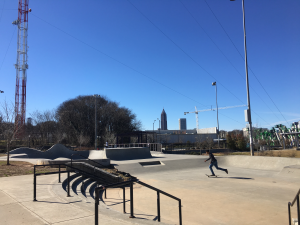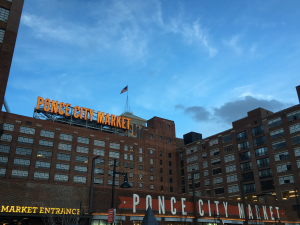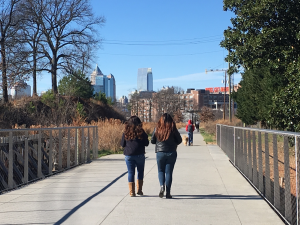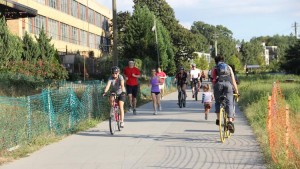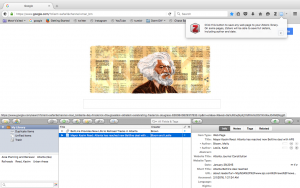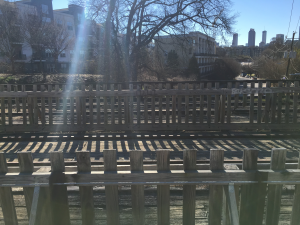 This picture of railroad tracks can be found at the Eastside Trail. It is important because the Atlanta Beltline is meant to cover the 27 miles of railroad tracks that are no longer in use. Currently only a few miles of the tracks have been covered in three different sections of the Beltline. The city of Atlanta plans on increasing the amount of trail when they secure more funding be it private, federal or local funding.
This picture of railroad tracks can be found at the Eastside Trail. It is important because the Atlanta Beltline is meant to cover the 27 miles of railroad tracks that are no longer in use. Currently only a few miles of the tracks have been covered in three different sections of the Beltline. The city of Atlanta plans on increasing the amount of trail when they secure more funding be it private, federal or local funding.
Atlanta Beltline: Digital Artifact 3
Atlanta Beltline: Digital Artifact 2
Depicted here is the Ponce City Market. Prior to being the Ponce City Market it stood as a Sears, Roebuck & Company and after that served as Atlanta’s City Hall. In 2012 it was purchased and leased out in increments to businesses and rented out to tenants. The building now hosts 20+ eateries, apartments, a parking garage, and will soon be the home to a few new offices.
Atlanta Beltline: Digital Artifact 1
The Atlanta Beltline’s Eastside Trail is used for many activities. This picture specifically showcases it as a haven for two friends to take a leisurely stroll and enjoy conversation and each others’ company. Further ahead a man is walking his Chow Chow and proves the Beltline to be pet friendly as they encountered no problems on their trip.
“Mayor Reed Transfers 10 Property Deeds to APS”
Saporta, Maria. “Atlanta Mayor Kasim Agrees to Transfer 10 Property Deeds to APS.” Saporta Report. N.p., 04 Feb. 2016. Web. 05 Feb. 2016. <http://saportareport.com/53810-2/>.
The article “Atlanta Mayor Transfers Property Deeds to APS” by Maria Saporta is important to our studies of the rhetoric of built environment for many reasons. Saporta aims to inform the readers of Mayor Reed’s plans to make amends with the Atlanta Public Schools over their budget cuts taken to help fund the Atlanta Beltline. Because the schools took budget cuts to support the Beltline, the schools were promised repayments which would be generated form the Beltline’s tax revenues. Because rthe city had not sent these repayments as they had promised, “the Atlanta Board of Education filed a lawsuit against the City last spring to gain control of the deeds of four former APS schools”. The Atlanta Public School system planned to use the vacant schools to sell to private firms who would revamp the school or land it was on. This is important because the turnout of the vacant schools could prove to help the area or add on to the built environment. Positively it could allow for new economic growth in the generally low-income areas, or it could lead to more gentrification and marginalized citizens having no other option but to leave their homes.
“The Atlanta BeltLine Eastside Trail”
Pittam, Rod. The Atlanta BeltLine Eastside Trail. 2010. Atlanta. The Atlanta Business Chronicle. Web. 5 Feb. 2016. <http://www.bizjournals.com/atlanta/morning_call/2015/12/city-of-atlanta-and-aps-closer-on-beltline-tax.html>.
This image is a perfect depiction of the Atlanta Beltline as it showcases the Beltline being a mixed-use trail. The Atlanta Beltline in this picture shows local residents, biking, running, and walking and a very diverse age range of people utilizing it. Many people use it for commuting to work, going shopping, exercise, or even for leisure time. This picture is also important because it includes a view of the once up and running business in the background which usually stands today as apartments or businesses along the Beltline. The revamping of these abandoned warehouses has proven to only expand the success of the Beltline by bringing in tax revenue and also bringing in new residents to the area. The revamping of local warehouses to bring revenue into the Beltline is exampled by the renewal of the Sears, Roebuck & Co. building in Atlanta into the Ponce City Market.
“Atlanta’s Popular BeltLine Trail Still Has Miles to Go”
Mehrotra, Krishna. “Atlanta’s Popular BeltLine Trail Still Has Miles to Go.” The Wall Street Journal. Dow Jones & Company, 31 July 2014. Web. 5 Feb. 2016. <http%3A%2F%2Fwww.wsj.com%2Farticles%2Fatlantas-popular-beltline-trail-still-has-miles-to-go-1406837184>.
Krishna Mehrotra’s article entitled “Atlanta’s Popular BeltLine Trail Still Has Miles to Go” is very influential for my studies of the Atlanta Beltline. The author includes a few hints as to how the Beltline is contributing to the built environment. Because legislation has allowed for the Beltline to be funded partially by taxes, money is being sourced from important aspects of Atlanta’s budget such as the Atlanta Public Schools. This legislation was “an agreement [using school property-tax revenues] between the city, the county and the public-school system, the BeltLine receives a portion of those parties’ property-tax revenues”. This agreement led to issues because the school system did not receive the revenues that were supposedly generated by the Beltline. The article also mentions that gentrification is taking place and parallels the Beltline to the Highline in New York City. Gentrification is occurring because “housing costs will be too high for current residents to remain” which runs lower income families out of their homes. I chose this article to represent my studies because it frequently shows how the addition of the Beltline may harm lower income families but also because it showcases some of the perks of the development of the Beltline. This article has light flaws because it lacks praise for the Beltline. The only statement made which was positive is when Mehrotra states “Skip Engelbrecht said business has tripled at his furniture store, Paris on Ponce, since he opened up a backdoor entrance from the BeltLine 2½ years ago” and a short intro of a woman praising her lack of need for a car because of living in such proximity to the Beltline. Otherwise the article rambles on the expense of the Beltline and ridicules the city for investing in such an expensive project.
About Me
2 Zotero Links
Atlanta Beltline: Bike Riders with Ponce City Market
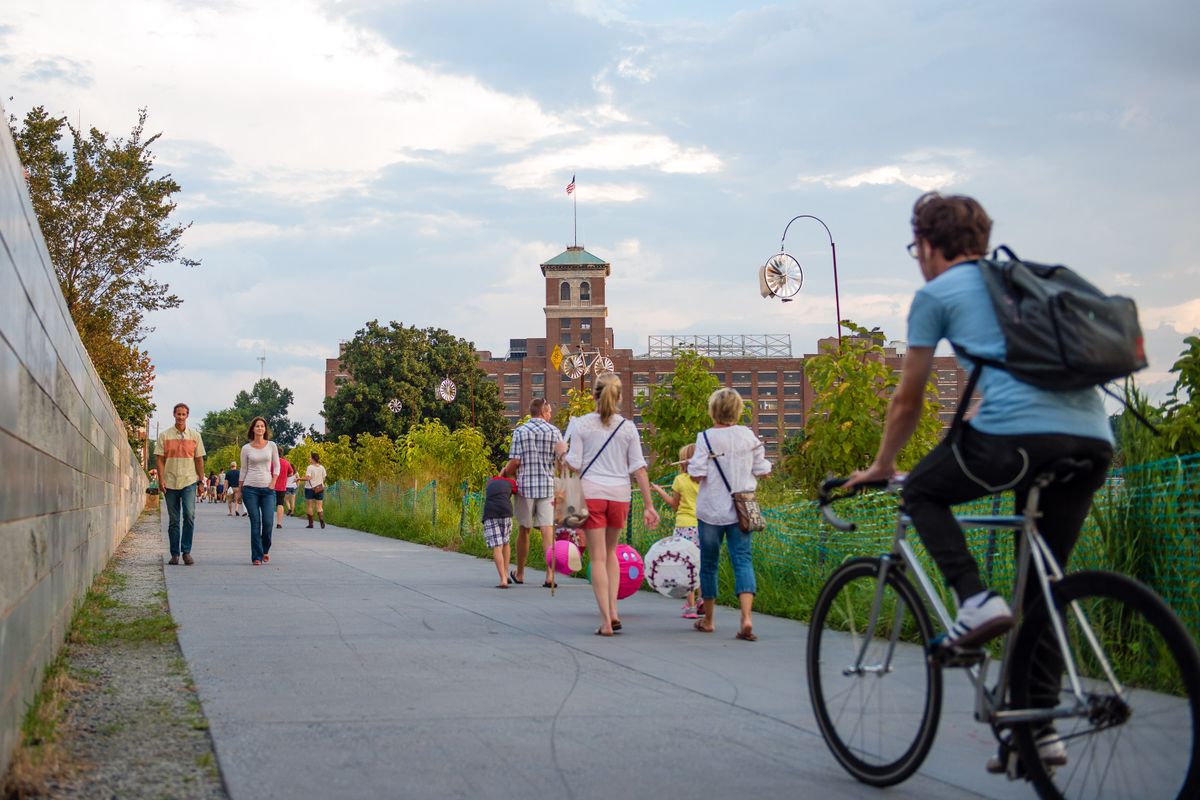
This picture portrays the mixed-use of the Beltline. Atlantans use it for exercise, commuting to and from work, and leisure activities.
